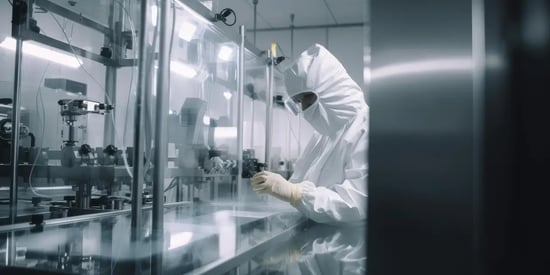As cleanroom technology advances, so do the methodologies and technologies for testing contaminants. It is essential for testing to keep pace with industry demands – detecting new sources of contaminates that put yields and regulatory compliance at risk.
Decades ago, cleanliness testing of cleanroom products was often performed by simply counting and characterizing particles under black lights with little to no magnification. Or by the rudimentary “clap test” to watch for the volume of visible particles released after clapping products together. These tests are primitive by today’s standards. Now we incorporate laser technology to measure and count air particles, along with sophisticated scanning electronic microscopes (SEM) to characterize and identify contaminants at an elemental level.
As cleanliness requirements become more stringent, detection levels must get tighter. Especially in semiconductor cleanroom requirements, where even microscopic particles can disrupt delicate circuitry, current testing methods will also become obsolete as technology and our understanding of cleanroom contaminants continue to improve.
It isn’t just testing technologies that have improved. IEST (Institute of Environmental Sciences and Technology) and ASTM (American Society for Testing and Materials) have developed and continually review best practices for rigorous, repeatable methodologies for cleanroom products. These best practices keep current with new tools and technologies that provide reliable, accurate detection and identification of micro-contamination, ultimately aiding in Cleanroom Compliance.
Detecting Unknown Contaminants
Advanced microscopy and SEM with energy dispersive x-ray analysis (SEM-EDX) have now uncovered that common additives used in manufacturing processes are sources of unwanted contamination. For instance, many cleanroom gloves contain pigments, often added to glove formulations to enhance color, mask defects, and hide fillers. Titanium dioxide (TiO2) is the most common pigment used to make translucent, pure nitrile look whiter. Yet, new detection technologies reveal this hard particle can cause corrosive contamination and magnetic interference in critical semiconductor and microelectronic cleanroom processes.
Contamination Risks from Packaging Exposed with Improved Testing
Contamination from corrugated cardboard and chipboard dispenser packaging has always been a known source of contamination. These common, paper-based packaging materials release particle fibers that are contaminants.
However, better detection and identification techniques have revealed that gloves, wipers, and other cleanroom products that come into direct contact with corrugated material expose cleanrooms to a wider range of microbial contamination risks, most notably endotoxin contamination. As detection methods for endotoxin contaminants continue to evolve, packaging is identified as an increasingly critical source of endotoxin contamination with major implications in certain pharmaceutical and medical device cleanroom processes.
Here are common industry recognized particle detection test equipment used to determine the cleanliness of critical gloves, wipers, apparel and other cleanroom products:
Optical Microscope:
Advanced microscopy uses visible light to determine the shape and characteristics (spherical, fibrous, etc.) of particle contamination from a prepared sample.
Air Particle Counter (APC):
APC optically counts and measures particles using lasers released into the environment from a cleanroom product (or sample) during pre-defined mechanical agitation, like a Helmke drum.
Liquid Particle Counter (LPC):
LPC counts the number of particles released from a cleanroom product (or a sample) after a pre-defined mechanical agitation in a known quantity of ultrapure water. LPC equipment incorporates lasers similarly to APC equipment but is more precise in measuring released particles within an enclosed liquid solution.
High-Performance Liquid Chromatography (HPLC):
HPLC chemically tests the extracted particles that are released from a cleanroom product (or sample) within a liquid solution and reports on the elements and their concentration.
Fourier Transform Infrared (FTIR) Spectroscopy:
FTIR Spectroscopy is a technique used to identify and analyze organic, polymeric, and inorganic materials using infrared light.
Scanning Electronic Microscopy (SEM)-Energy Dispersive X-Ray (EDX) Analysis:
SEM-EDX focuses a beam of electrons on a cleanroom product (or sample) to analyze the size, structure, and the chemical composition of submicron particles. While HPLC is a chemistry based test, SEM-EDX uses electrons. Testing requires a high level of expertise, and the equipment required is costly, but it represents the most sophisticated particle detection equipment currently available.

Not in this review of commonly conducted test methods and equipment are a number of internally developed, proprietary methods unique to specific company requirements. These include forms of tape transfer tests, surface probe tests, etc. While these might serve a specific and unique requirement – and may be quick and easy to conduct – they can be unreliable and are not a uniform, industry-accepted practice for testing cleanliness of cleanroom products.
It’s Time to Test to Current, Independent, Repeatable Cleanroom Testing Standards
When was the last time your organization requested or performed standardized, repeatable testing on your critical cleanroom products, incorporating these latest advancements in detection methods, to ensure cleanroom compliance and minimize risks?
If your cleanroom processes and operations are at the forefront of developing next generation products and technology, so should your methods for cleanroom product testing. You might learn about exposure to contamination risks that were previously undetectable. Successful outcomes depend on preventing contamination at an increasingly critical scale.
EXPLORE MORE RESOURCES
What Hidden Contaminants in Cleanroom Gloves Put Yields at Risk?
Why Repeatable, Standardized Testing is Important for Cleanroom Products

Valutek
Valutek is one of the first and few manufacturers to offer a full product portfolio of best-in-class cleanroom products. Since 1988, our controlled environment consumables are helping leading organizations operate their cleanrooms in a consistently stable state.
Related Articles
- Valutek

- 29 November 2023
Product Selection Secrets: How Matched Sets Define Cleanroom Cleanliness
Manufacturers often offer matched sets of products that are designed to work together for...
- Valutek

- 14 December 2023
Adhesive Mat Fundamentals: 3 Tips to Select & Install Cleanroom Mats
Adhesive mats remove contaminants from shoes, shoe covers, and cart wheels before entering...
- Valutek

- 21 August 2023
When Does It Expire? Understanding Shelf Life of Cleanroom Consumables
When it comes to cleanroom consumables, a product’s recommended shelf life or specific expiration...



